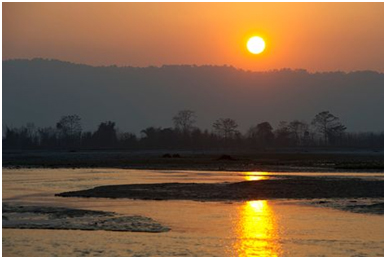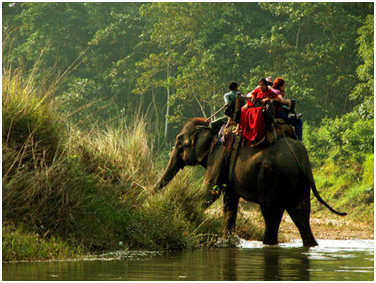- Home |
- Why With Us |
- About Us |
- Booking |
- Contact Us |
- Site Map
- Home
-
Nepal
-
Trekking
- Arun Valley with Gokyo Lakes
- Everest Base Camp Trek
- Everest- A Living Culture Exploration
- Everest Explore
- Everest Base Camp (via Thame) Trek
- Everest Base Camp with Kala Patthar
- Everest Comfort Trek
- Everest High Passes with Ama Dablam Base Camp
- Everest Mani Rimdu Festival Trek
- Everest Nagpa La Trek
- Everest with three high passes
- Gokyo Ri, Chola Pass & Chukung Ri with Kala Patthar
- Gokyo with Everest Base Camp
- Jomsom - Muktinath
- Jomsom - Muktinath
- Khayar Lake Trek
- Manaslu and Tsum Valley with Larkya La
- Upper Mustang Trek
- Manaslu High Circuit
- Manaslu, Tilicho Pass & Upper Mustang
- Annapurna Base Camp Trek
- The Annapurna Circuit Trek
- Annapurna Panorama
- Nar and Phu Valley Trekking
- Nepal Rhododendron Trek
- Royal Trek
- Saribung Trek and Expedition
- Annapurna Sanctuary Trek
- The Annapurna Sunrise Trek
- Expedition
-
Rafting
-
Peak Climbing
-
Tours
- Kathmandu-Chitwan-Jungle Tour with visit to Pokhara
- Dawn to Dusk Tour
- Historical, Natural & Cultural Tour with Camping
- Kathmandu Valley Temple Tour
- Temple - Panorama - Jungle Tour
- Taste of Nepal
- Central Nepal Tour
- Explore Nepal Tour & Trek
- Nepal Cross-country Tour
- Best of Nepal Tour & Treks
- Kathmandu valley rim Tour & Treks
- Nepal Culture Tour
- Introduction to Nepal Tour & Treks
- Nepal at a glance Tour & Treks
- Wonders of Nepal Tour & Treks
- Glimpses of Nepal Tour & Treks
- Through the Silhouette Tour & Treks
- Tent and Temple Tour
- Kathmandu-Chitwan-Pokhara Tour
- Historical, Cultural City and Jungle Tour
- Nepal Wildlife Tour
- Nepal Panorama Historical Tour
- Nepal Adventure Tour
- Nepal Pilgrimage Tour
- Ghalegaun-Ghanapokhara Homestay Tour
- Jungle Safari
- Adventure Sports
-
Trekking
- Tibet
-
Bhutan
-
India
- Yoga Tour
- About Us
-
The Great Himalayan Trail
-
Short Tours/Treks

Chitwan National Park
 Chitwan National Park lies in the lowlands or Inner Terai of southern central Nepal on the international border with India. The park covers 932 km2 of subtropical lowland, wedged between two east-west river valleys at the base of the Siwalik range of the outer Himalayas.
Chitwan National Park lies in the lowlands or Inner Terai of southern central Nepal on the international border with India. The park covers 932 km2 of subtropical lowland, wedged between two east-west river valleys at the base of the Siwalik range of the outer Himalayas.
Chitwan is dominated by almost monotypic stands of sal forest which occupy 60% of the total area and is a remnant of the lowland Terai forest which once stretched across the foothills of the Himalayas through India and Nepal. Riverine forest and grasslands form a mosaic along the river banks are maintained by seasonal flooding. On the hills are pines and scattered palms, and moister slopes support bamboos.
Chitwan is situated in a river valley basin or dun, along the flood plains of the Rapti, Reu and Narayani rivers. The Narayani is also called the Gandaki and is the third-largest river in Nepal. It originates in the high Himalaya and, drains into the Bay of Bengal. The Siwaliks show a distinctive fault pattern that has produced steep cliffs on the south-facing slopes, where vegetation cover is poorer than the northern slopes. The flood plains comprise a series of ascending alluvial terraces laid down by the rivers and subsequently raised by Himalayan uplift. The terraces are composed of layers of boulders and gravels set in a fine silty matrix.
The climax vegetation of the Inner Terai is sal forest, which covers some 60% of the park. However, floods, fires and riverine erosion combine to make a continually changing mosaic of grasslands and riverine forests in various stages of succession. Purest stands of sal occur on better drained ground such as the lowlands around Kasra in the centre of the park. Elsewhere, sal is intermingled with chir pine along the southern face of the Churia Hills and with tree species. Creepers are common. The under-storey is scant with the exception of grasses.
 The park contains the last Nepalese population (estimated at 400) of the endangered great one-horned Asian rhinoceros which is the second largest concentration of this species to occur after Kaziranga National Park in India. Royal Chitwan is also one of the last strongholds of the Royal Bengal tiger. Other threatened mammals occurring in the park include leopard, wild dog, sloth bear and gaur. Other mammals include sambar, chital, hog deer, barking deer, wild pig, monkeys, otter, porcupine, yellow-throated marten, civet, fishing cat, jungle cat, jackal, striped hyena and Indian fox. Aquatic species include the gangetic dolphin, the mugger crocodile and the endangered gharial.
The park contains the last Nepalese population (estimated at 400) of the endangered great one-horned Asian rhinoceros which is the second largest concentration of this species to occur after Kaziranga National Park in India. Royal Chitwan is also one of the last strongholds of the Royal Bengal tiger. Other threatened mammals occurring in the park include leopard, wild dog, sloth bear and gaur. Other mammals include sambar, chital, hog deer, barking deer, wild pig, monkeys, otter, porcupine, yellow-throated marten, civet, fishing cat, jungle cat, jackal, striped hyena and Indian fox. Aquatic species include the gangetic dolphin, the mugger crocodile and the endangered gharial.
At the foot of the Himalayas, Chitwan is one of the few remaining undisturbed vestiges of the 'Terai' region, which formerly extended over the foothills of India and Nepal. It has a particularly rich flora and fauna. One of the last populations of single-horned Asiatic rhinoceros lives in the park, which is also one of the last refuges of the Bengal tiger.
Prior to its re-introduction to Royal Bardia National Park in 1986, the park contained the last Nepalese population of the Indian rhinoceros. Tiger is present and has been the subject of a long-term study begun in 1974. Over 350 bird species are reported. Himalayan grey-headed fishing eagle and white-back vulture. Ruddy shelduck and bar-headed goose winter on the rivers. The threatened Indian python also occurs within the park, and some 99 fish species inhabit the rivers and oxbow lakes.
Source: UNESCO/CLT/WHC
Historical Description Chitwan was declared a national park in 1973, following approval by the late King Mahendra in December 1970. The bye-laws (Royal Chitwan National Park Regulations) were introduced on 4 March 1974. Substantial additions were made to the park in 1977 and the adjacent Pars a wildlife Reserve was established in 1984. The habitat had been well protected as a royal hunting reserve from 1846 to 1951 during the Rana regime. An area south of the Rapti River was first proposed as a rhinoceros sanctuary in 1958 (Gee, 1959), demarcated in 1963 (Gee, 1963; Willan, 1965) and later incorporated into the national park. Chitwan was designated as a World Heritage site in November 1984.
Chitwan was declared a national park in 1973, following approval by the late King Mahendra in December 1970. The bye-laws (Royal Chitwan National Park Regulations) were introduced on 4 March 1974. Substantial additions were made to the park in 1977 and the adjacent Pars a wildlife Reserve was established in 1984. The habitat had been well protected as a royal hunting reserve from 1846 to 1951 during the Rana regime. An area south of the Rapti River was first proposed as a rhinoceros sanctuary in 1958 (Gee, 1959), demarcated in 1963 (Gee, 1963; Willan, 1965) and later incorporated into the national park. Chitwan was designated as a World Heritage site in November 1984.
General info
Activities: jungle safari on elephant back, jungle walk, canoe ride, jeep drive, and observation of Tharu culture.
Accommodation: resorts, hotel and lodges
Access: The park headquarter at Kasara is a 21 km drive from Bharatpur which is 20 minutes by air or 146 km by road from Kathmandu.
Best seasons: Oct – Feb (average temperature 25 degree celcius), March –June (hot, upto 43 degree), July – Sept (rainy).

- History
- Overview
- Ancient Nepal
- The Early Kingdom of the Licchavis
- Medieval Nepal, 750-1750
- The Malla Kings
- The Three Kingdoms
- The Making of Modern Nepal
- The Struggle for Power
- The Enclosing of Nepal
- Infighting among Aristocratic Factions
- Rana Rule
- The Ranas
- The Growth of Political Parties
- The Return of the King
- The Democratic Experiment
- The Panchayat System under King Mahendra
- King Birendra
- Movement to restore democracy
- Maoist Insurgency
- Struggle for Democracy
- King's Direct Rule
- People's Movement
- The Constitutional Assembly Election
- Government and Political Conditions
- Geography
- Festivals of Nepal
- Overview
- Bada Dashain (September-October)
- Sri Panchami or Basanta Panchami
- Tihar and Laxmi Puja - festival of lights (Oct-Nov)
- Maghe Sankranti
- Naga Panchami
- Janai Poornima (Rokshya Bandhon)
- Gaijatra
- Pancha Dan
- Teej and Rishi Panchani
- Indrajatra
- Ghanta Karna
- Buddha Jayanti
- Maha Shivaratri
- Phagu Poornima or Holy
- Ghode Jatra
- Chaite Dashain
- Nava Varsha / New Year
- Festival of Seto Machhendranath
- Matatirtha Aunsi or Mother\'s Day
- Bala Chaturdashi
- Sri Krishna Janmastami
- Rama Nawami
- Mani Rimdu festival - Everest Region
- Tiji Festival, Mustang
- Dumje Festival - Everest Region
- Flora and Fauna of Nepal
- Flowering Plants of Nepal
- Getting in to Nepal
- Climate
- Nepal Visa Procedures
- Nepalese Embassies and Consulates Abroad
- Places visit in Nepal
- Orchids of Nepal
- World Heritage Sites of Nepal
Trekking in Nepal
Expeditions In Nepal
Rafting in Nepal
Tours in Nepal
All rights reserved.



